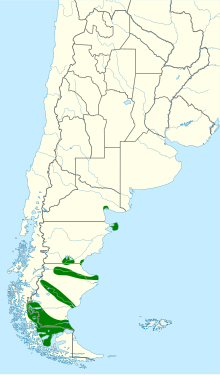| Austral rail | |
|---|---|

| |
| Conservation status | |
 Vulnerable (IUCN 3.1) | |
| Scientific classification | |
| Domain: | Eukaryota |
| Kingdom: | Animalia |
| Phylum: | Chordata |
| Class: | Aves |
| Order: | Gruiformes |
| Family: | Rallidae |
| Genus: | Rallus |
| Species: | R. antarcticus |
| Binomial name | |
| Rallus antarcticus King, 1828 | |

| |
The austral rail (Rallus antarcticus) is a Vulnerable species of bird in subfamily Rallinae of family Rallidae, the rails, gallinules, and coots. It is found in Argentina and Chile.
Taxonomy and systematics
Some authors have considered the austral rail as conspecific with the Virginia rail (R. limicola) but their treatment has not been widely accepted. The species is monotypic.
Description
The austral rail is about 20 cm (7.9 in) long. Adults have dull brown upperparts with buff-edged black centers to the back feathers. Their face and throat are gray, their breast olive brown, and their flanks barred with black and white. Juveniles are similar with the addition of sooty tips on the breast feathers and a white throat.
Distribution and habitat
The austral rail is patchily distributed in southern Chile's Magallanes Region and in southern Argentina between the departments of Río Negro and Santa Cruz. It formerly occurred as far north as Santiago, Chile, and Buenos Aires, Argentina. It has also been recorded as a vagrant on the Falkland Islands. It is found mostly near the coast where it inhabits wet fields and meadows, rushy lake shores, and reedbeds.
Behavior
Movement
Some of the southernmost populations appear to move north during the austral autumn.
Feeding
Little is known about the austral rail's foraging behavior and diet. Both are assumed to be similar to that of the Ecuadorian rail (R. aequatorialis), which has an eclectic diet.
Breeding
The austral rail's breeding biology is almost unknown. It appears to breed during October and November in Chile and November in Argentina. What is thought to be its nest was on the ground under a bramble; it was a depression in the ground lined with grass and rushes and held eight eggs.
|
Songs and calls Listen to austral rail on xeno-canto |
Vocalization
The austral rail's main vocalization is "a series of high-pitched notes 'pee', 'peeree', 'peek' etc." which is often given in duet. It also makes "low booming sounds or grunts" and "a rather drawn-out single squeal."
Status
The IUCN originally assessed the austral rail in 1988 as Threatened, then in 1994 as Critically Endangered, and since 2000 as Vulnerable. There were no documented records between 1959 and 1998 and is currently known from a limited number of locations. It has an estimated population of between 2500 and 10,000 mature individuals though the number might be as low as 1000, and the population is believed to be declining. The principal threat is grazing in its habitat but water diversion and introduced American mink (Neogale vison) also contribute to its decline. It is found in five formally protected areas and some de facto protected private lands.
References
- ^ BirdLife International (2021). "Austral Rail Rallus antarcticus". IUCN Red List of Threatened Species. 2021: e.T22692486A197497364. doi:10.2305/IUCN.UK.2021-3.RLTS.T22692486A197497364.en. Retrieved 23 November 2022.
- ^ Gill, F.; Donsker, D.; Rasmussen, P., eds. (August 2022). "Finfoots, flufftails, rails, trumpeters, cranes, Limpkin". IOC World Bird List. v 12.2. Retrieved August 9, 2022.
- ^ HBW and BirdLife International (2021) Handbook of the Birds of the World and BirdLife International digital checklist of the birds of the world. Version 6. Available at: http://datazone.birdlife.org/userfiles/file/Species/Taxonomy/HBW-BirdLife_Checklist_v6_Dec21.zip retrieved August 7, 2022
- Clements, J. F., T. S. Schulenberg, M. J. Iliff, T. A. Fredericks, J. A. Gerbracht, D. Lepage, S. M. Billerman, B. L. Sullivan, and C. L. Wood. 2022. The eBird/Clements checklist of birds of the world: v2022. Downloaded from https://www.birds.cornell.edu/clementschecklist/download/ retrieved November 10, 2022
- Remsen, J. V., Jr., J. I. Areta, E. Bonaccorso, S. Claramunt, A. Jaramillo, D. F. Lane, J. F. Pacheco, M. B. Robbins, F. G. Stiles, and K. J. Zimmer. Version 24 July 2022. A classification of the bird species of South America. American Ornithological Society. https://www.museum.lsu.edu/~Remsen/SACCBaseline.htm retrieved July 24, 2022
- ^ Taylor, B., P. F. D. Boesman, E. de Juana, and C. J. Sharpe (2020). Austral Rail (Rallus antarcticus), version 1.0. In Birds of the World (J. del Hoyo, A. Elliott, J. Sargatal, D. A. Christie, and E. de Juana, Editors). Cornell Lab of Ornithology, Ithaca, NY, USA. https://doi.org/10.2173/bow.ausrai1.01 retrieved November 23, 2022
- Remsen, J. V., Jr., J. I. Areta, E. Bonaccorso, S. Claramunt, A. Jaramillo, D. F. Lane, J. F. Pacheco, M. B. Robbins, F. G. Stiles, and K. J. Zimmer. Version 24 July 2022. Species Lists of Birds for South American Countries and Territories. https://www.museum.lsu.edu/~Remsen/SACCCountryLists.htm retrieved July 24, 2022
- Conway, C. J. (2020). Virginia Rail (Rallus limicola), version 1.0. In Birds of the World (A. F. Poole and F. B. Gill, Editors). Cornell Lab of Ornithology, Ithaca, NY, USA. https://doi.org/10.2173/bow.virrai.01 retrieved November 23, 2022
